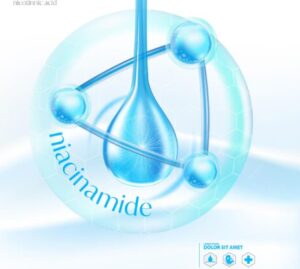Niacinamide and Vitamin C:
There’s been a lot of confusion in the skincare world about whether niacinamide and vitamin C can be used together. You’ve probably seen conflicting advice online, with some experts saying they’re a powerful combination while others warn they’ll cancel each other out or irritate your skin.
So what’s the truth? As someone who’s spent years researching cosmetic ingredients, I’m here to clear up the confusion once and for all. The answer might surprise you, and it’s going to change how you approach your morning skincare routine.
Understanding Niacinamide: The Multi-Tasking Powerhouse
Before we dive into the compatibility debate, let’s talk about what niacinamide actually does for your skin. Also known as vitamin B3, niacinamide is one of those rare ingredients that seems to benefit virtually everyone, regardless of skin type or concern.
What Makes Niacinamide Special?
Niacinamide is a water-soluble vitamin that your skin cells convert into coenzymes called NAD and NADP. These coenzymes are essential for hundreds of metabolic processes in your skin. In simpler terms, niacinamide helps your skin function better on a cellular level.

The Benefits of Niacinamide
Strengthens Your Skin Barrier: Niacinamide increases the production of ceramides and other lipids that make up your skin’s protective barrier. This means less moisture loss and better protection against environmental damage.
Reduces Inflammation: If you struggle with redness, sensitivity, or conditions like rosacea, niacinamide’s anti-inflammatory properties can make a noticeable difference.
Controls Oil Production: For those with oily or acne-prone skin, niacinamide helps regulate sebum production without drying out your skin.
Fades Hyperpigmentation: Niacinamide reduces the transfer of melanin to skin cells, which helps fade dark spots, acne scars, and uneven skin tone.
Minimizes Pore Appearance: By regulating oil and improving skin texture, niacinamide can make pores look smaller over time.
Fights Signs of Aging: It stimulates collagen production and reduces oxidative stress, helping to smooth fine lines and improve skin elasticity.
The concentration typically used in skincare products ranges from 2% to 10%, with 5% being the sweet spot for most people.
Vitamin C: The Brightening Antioxidant
Now let’s talk about vitamin C, which has earned its reputation as one of the most effective skincare ingredients for brightness and anti-aging.
The Different Forms of Vitamin C
This is where things get a bit technical, but stick with me because it matters. Vitamin C comes in several different forms, and not all of them are created equal.
L-Ascorbic Acid: This is pure vitamin C and the most researched form. It’s also the most potent but also the most unstable and potentially irritating. It needs to be formulated at a low pH (around 3.5) to be effective.
Ascorbyl Glucoside: A more stable, gentle derivative that converts to vitamin C in the skin. It’s less irritating but also less potent than L-ascorbic acid.
Sodium Ascorbyl Phosphate: Another stable derivative that works well for acne-prone skin because it has antibacterial properties.
Magnesium Ascorbyl Phosphate: Highly stable and hydrating, this form is excellent for sensitive or dry skin.
Tetrahexyldecyl Ascorbate: An oil-soluble form that penetrates deeply and is very stable. It’s pricey but effective.

What Vitamin C Does for Your Skin
Brightens and Evens Tone: Vitamin C inhibits an enzyme called tyrosinase, which is necessary for melanin production. This helps fade dark spots and prevents new ones from forming.
Powerful Antioxidant Protection: It neutralizes free radicals caused by UV exposure, pollution, and other environmental stressors that accelerate aging.
Boosts Collagen Production: Vitamin C is essential for collagen synthesis, helping to maintain skin firmness and reduce the appearance of wrinkles.
Reduces Inflammation: It has anti-inflammatory properties that can help with acne and redness.
Enhances Sun Protection: While it’s not a substitute for sunscreen, vitamin C provides an extra layer of antioxidant protection against UV damage.
Effective concentrations typically range from 10% to 20% for L-ascorbic acid, though derivatives may be used at different percentages.
The Great Debate: The Origin of the Myth
So where did this whole “don’t mix niacinamide and vitamin C” warning come from? The answer takes us back to older research from the 1960s.
Early studies suggested that when niacinamide and ascorbic acid (vitamin C) were combined at high temperatures and in very acidic conditions, they could potentially convert into nicotinic acid (niacin). Nicotinic acid can cause temporary flushing and redness in some people.
Here’s the key point: these studies were conducted under laboratory conditions that don’t reflect how you actually use skincare products. The combination would need to be:
- Mixed together in the same formulation
- Stored at high temperatures
- Left to sit for extended periods
- In a very acidic pH environment
Modern skincare formulations are much more sophisticated, and cosmetic chemists have long since figured out how to stabilize these ingredients.
The Current Scientific Consensus
Fast forward to today, and the scientific community agrees: niacinamide and vitamin C can absolutely be used together safely and effectively. Multiple recent studies have confirmed this.
A 2017 study published in the journal Clinical, Cosmetic and Investigational Dermatology specifically tested the combination of 15% vitamin C and 5% niacinamide. The results? No irritation, no reduced efficacy, and participants saw improvements in fine lines, wrinkles, and skin tone.
Modern vitamin C serums are formulated with stabilizers and at controlled pH levels that prevent any problematic interactions. Plus, even if some minimal conversion to nicotinic acid did occur, the amount would be so small that it wouldn’t cause any noticeable effects.
How to Use Niacinamide and Vitamin C Together
Now that we’ve established these ingredients play well together, let’s talk about the best ways to incorporate both into your routine.
Option 1: Use Them at Different Times of Day
Many people prefer to use vitamin C in the morning and niacinamide in the evening, or vice versa. This approach works well if you want to keep things simple or if you’re using multiple serums and want to avoid layering too many products at once.
Morning Routine with Vitamin C:
- Cleanser
- Toner (optional)
- Vitamin C serum
- Moisturizer
- Sunscreen
Evening Routine with Niacinamide:
- Cleanser
- Toner (optional)
- Niacinamide serum
- Moisturizer or night cream
This method is particularly good if you’re new to either ingredient and want to introduce them gradually.

Option 2: Layer Them in the Same Routine
If your skin tolerates both ingredients well, you can absolutely layer them in the same routine. The key is to apply them in the right order.
Apply Vitamin C First: Since most effective vitamin C serums (especially L-ascorbic acid) have a lower pH, apply them first. Let it absorb for a minute or two.
Then Apply Niacinamide: Follow with your niacinamide serum. This gives the vitamin C time to work at its optimal pH before the higher pH niacinamide is applied.
Seal with Moisturizer: Finish with your regular moisturizer to lock everything in.
Some people experience slight tingling or temporary redness when first layering these ingredients, but this usually subsides within a few minutes and decreases as your skin adapts.
Option 3: Use a Product with Both
Several skincare brands now offer products that contain both niacinamide and vitamin C in the same formulation. These are specially formulated to ensure stability and efficacy of both ingredients.
When choosing a combined product, look for vitamin C derivatives rather than pure L-ascorbic acid, as they’re more stable at the higher pH needed for niacinamide to work effectively.
Choosing the Right Concentrations
When using both ingredients, you don’t necessarily need the highest concentrations of each to see results.
For Beginners
Start with:
- 5% niacinamide
- 10-15% vitamin C (or a gentle derivative)
This combination is effective for most people while minimizing the risk of irritation.
For Experienced Users
Once your skin has built tolerance, you can increase to:
- 10% niacinamide
- 15-20% vitamin C
However, more isn’t always better. Some people see their best results at lower concentrations, especially if they have sensitive skin.
What to Expect: Realistic Timelines
Skincare ingredients don’t work overnight, and it’s important to have realistic expectations.
Weeks 1-2: You might notice slight improvements in skin texture and radiance. Some people experience temporary purging or mild irritation as their skin adjusts.
Weeks 4-6: More noticeable brightening effects, improved skin tone evenness, and reduced appearance of recent dark spots.
Weeks 8-12: Significant improvements in hyperpigmentation, skin texture, fine lines, and overall radiance. This is when most people see the full benefits.
Consistency is key. Using these ingredients sporadically won’t give you the results you’re looking for.
Potential Side Effects and How to Handle Them
While both niacinamide and vitamin C are generally well-tolerated, some people do experience side effects.
Mild Tingling or Flushing
This is most common when first layering the products and usually subsides within a few minutes. It’s typically harmless, but if it persists or is uncomfortable, try:
- Using the ingredients at different times of day
- Reducing the concentration
- Buffering with a hydrating toner between layers
Irritation or Redness
If you experience significant irritation:
- Stop using both products for a few days
- Reintroduce them one at a time
- Consider that another product in your routine might be the culprit
- Try gentler forms of vitamin C like ascorbyl glucoside
Increased Sensitivity
Some people find their skin becomes more sensitive when using vitamin C. If this happens:
- Make sure you’re using sunscreen daily (non-negotiable when using vitamin C)
- Reduce frequency of application
- Avoid using other potentially irritating ingredients like retinol at the same time initially
Ingredients That Pair Well With This Combination
If you want to build a comprehensive routine, here are ingredients that work beautifully alongside niacinamide and vitamin C:
Hyaluronic Acid: Provides hydration and helps buffer any potential irritation. Apply after your active serums.
Ceramides: Work synergistically with niacinamide to strengthen your skin barrier.
Ferulic Acid: Often combined with vitamin C to boost its stability and effectiveness.
Peptides: Can be used alongside both niacinamide and vitamin C for additional anti-aging benefits.
Sunscreen: Absolutely essential when using vitamin C. It enhances your sun protection and prevents the oxidation of vitamin C.
Ingredients to Be Cautious With
While niacinamide and vitamin C can work together, adding too many actives at once can overwhelm your skin.
Retinol/Retinoids: Can be used in the same routine as niacinamide and vitamin C, but start slowly. Many people prefer to use retinol only at night.
AHA/BHA Exfoliants: These can be used in your routine but perhaps not in the same application. Consider using them at different times of day or on alternate days.
Benzoyl Peroxide: Can oxidize vitamin C, so it’s best to use them at different times of day if you need both.
Product Recommendations Guide
When shopping for products, here’s what to look for:
For Vitamin C Serums:
- Dark or opaque bottles (vitamin C degrades with light exposure)
- Airtight packaging (pump bottles are better than droppers)
- Products stored in cool, dark places
- Fresh products (vitamin C oxidizes over time)
- Look for dates or batch numbers
For Niacinamide Products:
- Listed in the first 5 ingredients for effectiveness
- Minimal fragrance or essential oils if you have sensitive skin
- Complementary ingredients like zinc, panthenol, or ceramides
The Bottom Line: Should You Use Both?
The short answer is yes, most people can benefit from using both niacinamide and vitamin C in their skincare routine. The combination offers comprehensive benefits:
- Vitamin C provides antioxidant protection and brightening
- Niacinamide supports skin barrier function and reduces inflammation
- Together, they address multiple skin concerns simultaneously
The myth that they can’t be used together is outdated and not supported by modern research or formulation science. What matters more is:
- Choosing high-quality products
- Applying them correctly
- Being consistent with your routine
- Listening to your skin and adjusting as needed
Remember, skincare is highly individual. What works for your favorite influencer might not work exactly the same for you. Start with lower concentrations, introduce one ingredient at a time, and give your skin time to adjust.
If you experience persistent irritation or don’t see results after 12 weeks, consider consulting with a dermatologist who can provide personalized recommendations based on your specific skin concerns.
The good news? For most people, niacinamide and vitamin C together create a powerhouse combination that delivers visible results. Your skin will thank you for giving it both the antioxidant protection of vitamin C and the multi-tasking benefits of niacinamide.


